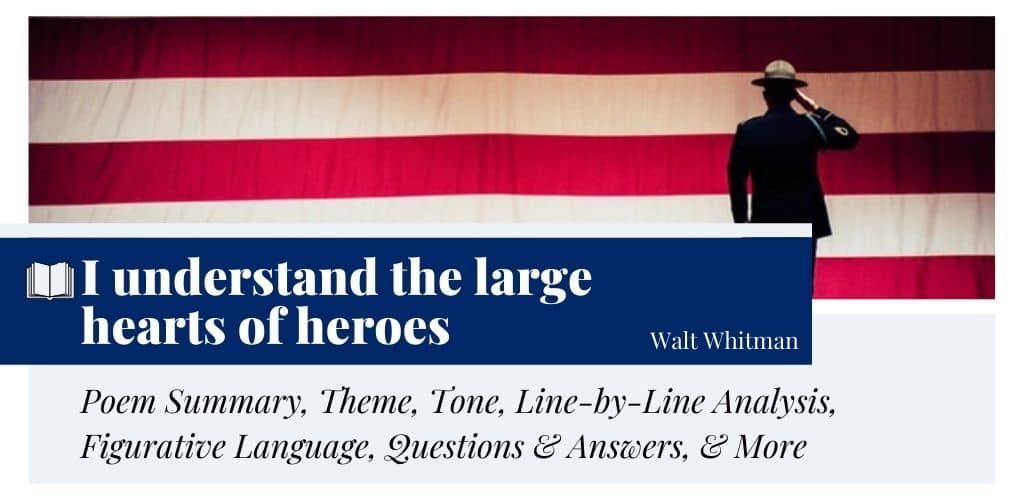I understand the large hearts of heroes by Walt Whitman
“I understand the large hearts of heroes” comprises the last forty-nine lines of Walt Whitman’s “Song of Myself, 33,” starting from the line in the title to “He gasps through the clot Mind not me—mind—the entrenchments.” This poem is about the deeds of forgotten heroes with whom the first-person poet-speaker associates himself. He not only empathizes with their gory tragedies but he also becomes themselves. He becomes one with the sailor, who saved a thousand lives from Death. Not only that he tries to be in the shoes of those whose names will never see the face of history books.
- Read the full poem “I understand the large hearts of heroes” below:
I understand the large hearts of heroes by Walt Whitman I understand the large hearts of heroes, The courage of present times and all times, How the skipper saw the crowded and rudderless wreck of the steam-ship, and Death chasing it up and down the storm, How he knuckled tight and gave not back an inch, and was faithful of days and faithful of nights, And chalk'd in large letters on a board, Be of good cheer, we will not desert you; How he follow'd with them and tack'd with them three days and would not give it up, How he saved the drifting company at last, How the lank loose-gown'd women look'd when boated from the side of their prepared graves, How the silent old-faced infants and the lifted sick, and the sharp-lipp'd unshaved men; All this I swallow, it tastes good, I like it well, it becomes mine, I am the man, I suffer'd, I was there. The disdain and calmness of martyrs, The mother of old, condemn'd for a witch, burnt with dry wood, her children gazing on, The hounded slave that flags in the race, leans by the fence, blowing, cover'd with sweat, The twinges that sting like needles his legs and neck, the murderous buckshot and the bullets, All these I feel or am. I am the hounded slave, I wince at the bite of the dogs, Hell and despair are upon me, crack and again crack the marksmen, I clutch the rails of the fence, my gore dribs, thinn'd with the ooze of my skin, I fall on the weeds and stones, The riders spur their unwilling horses, haul close, Taunt my dizzy ears and beat me violently over the head with whip-stocks. Agonies are one of my changes of garments, I do not ask the wounded person how he feels, I myself become the wounded person, My hurts turn livid upon me as I lean on a cane and observe. I am the mash'd fireman with breast-bone broken, Tumbling walls buried me in their debris, Heat and smoke I inspired, I heard the yelling shouts of my comrades, I heard the distant click of their picks and shovels, They have clear'd the beams away, they tenderly lift me forth. I lie in the night air in my red shirt, the pervading hush is for my sake, Painless after all I lie exhausted but not so unhappy, White and beautiful are the faces around me, the heads are bared of their fire-caps, The kneeling crowd fades with the light of the torches. Distant and dead resuscitate, They show as the dial or move as the hands of me, I am the clock myself. I am an old artillerist, I tell of my fort's bombardment, I am there again. Again the long roll of the drummers, Again the attacking cannon, mortars, Again to my listening ears the cannon responsive. I take part, I see and hear the whole, The cries, curses, roar, the plaudits for well-aim'd shots, The ambulanza slowly passing trailing its red drip, Workmen searching after damages, making indispensable repairs, The fall of grenades through the rent roof, the fan-shaped explosion, The whizz of limbs, heads, stone, wood, iron, high in the air. Again gurgles the mouth of my dying general, he furiously waves with his hand, He gasps through the clot Mind not me—mind—the entrenchments. - from "Song of Myself, 33"

Summary
In “I understand the large hearts of heroes,” Whitman’s persona declares his oneness with each individual, who stood boldly against the face of danger, atrocity, hopelessness, and, most importantly, “Death.” He understands the “large hearts,” the unmeasurable courage of heroes: the sailor, who saved the shipwrecked souls from their impending death; the mother, who was condemned for witchcraft and burnt alive; the hounded slave, who relentlessly fought with shame and agony each day; the mashed fireman under debris; an old artillerist; the dying general. The speaker empathizes with every one of them and catalogs their tale in a journalistic and pictorial fashion.
Structure & Form
Whitman’s free-verse piece “I understand the large hearts of heroes” consists of a total of forty-nine lines without a regular rhyme scheme or meter. Each line, both long and short, presents a complete idea in itself. Whitman creates internal rhyming with the use of repetition, parallel structures, and alliteration. The grouping of lines into specific stanzas depends on the central idea or image of the section. For instance, the first eleven lines build the narrative of the skipper who saved the shipwrecked individuals. Apart from that, the overall poem is written from the first-person point of view.
Poetic Devices & Figurative Language
In Whitman’s “I understand the large hearts of heroes,” there are a number of important poetic devices and figurative techniques that include the following:
Anaphora
It is one of the important poetic devices used in the text. Readers can find anaphora in the following lines:
- Lines 3-4 (beginning with “How”)
- Lines 6-9 (beginning with “How”)
- Lines 12-15 (beginning with “The”)
- Lines 19-20 (beginning with “I”)
- Lines 37-38 (beginning with “I”)
- Lines 39-41 (beginning with “Again”)
- Lines 43-44 (beginning with “The”)
- Lines 46-47 (beginning with “The”)
The use of anaphora in these lines creates a rhythm while reading even though there is no set rhyming scheme or meter.
Personification
It occurs in the phrase, “Death chasing it up and down the storm”. The word “Death” starts with the capital “D”, which means it is personified. Besides, the idea of death is invested with the idea of chasing the ship like a wild creature.
Alliteration
The repetition of the same sound at the beginning of neighboring words is called alliteration. It can be found in the following phrases:
- “hearts of heroes”
- “skipper saw”
- “lank loose-gown’d women look’d”
- “head with whip-stocks”
- “breast-bone broken”
- “Distant and dead”
- “cries, curses”
- “rent roof”
Whitman also uses consonance and assonance in the poem. For instance, in “I heard the distant clicks of their picks and shovels,” there is a consonance of the “k” sound. There is assonance of the “i” sound in “whizz of limbs”.
Metaphor
The first metaphor can be found in this line, “All this I swallow, it tastes good, I like it well”. Through this line, the speaker compares the human experiences mentioned in lines 3-9 to something that is edible. He assimilates human experiences, which is why he does not need to “ask the wounded person how he feels”.
Furthermore, the line “Agonies are one of my changes of garments,” contains another metaphorical comparison between agony and garment. The speaker compares agony, a human emotion, to a garment that he wears and puts on another often. Similarly, readers can find a metaphor in the line, “I am the clock myself.”
Onomatopoeia
Onomatopoeia, the use of words that imitates natural sounds, can be found in the following instances:
- “How he knuckled tight”
- “crack and again crack the marksmen”
- “The whizz of limbs, heads, stone, wood, iron, high in the air”
Allusion
The first stanza contains an allusion to a real incident. In 1853, the ship San Francisco sailed from New York City to South America. After being hit by a storm, the ship lost its way to the port. Later the captain (“skipper”) of another ship rescued the survivors. The incident was reported in the New York Weekly Tribune, the copy of which was found in Whitman’s papers upon his death.
Imagery
Whitman uses vivid imagery to provide the accounts of the unnamed “heroes”. For instance, in the first stanza, he employs visual imagery in a cinematic flashback technique in order to depict the story of the skipper who saved the shipwrecked passengers. Similarly, he uses tactile and visual imagery to paint the suffering of the “hounded slave”:
The hounded slave that flags in the race, leans by the fence, blowing, cover’d with sweat,
The twinges that sting like needles his legs and neck, the murderous buckshot and the bullets,
…
I clutch the rails of the fence, my gore dribs, thinn’d with the ooze of my skin,
I fall on the weeds and stones,
The riders spur their unwilling horses, haul close,
Taunt my dizzy ears and beat me violently over the head with whip-stocks.
In the penultimate stanza, Whitman depicts an explosion through auditory and visual imagery:
The fall of grenades through the rent roof, the fan-shaped explosion,
The whizz of limbs, heads, stone, wood, iron, high in the air.
Symbolism
In the very first line of the poem, the “large hearts” is a symbol of courage, endurance, and will. In “They show the dial or move as the hands of me, I am the clock myself,” the speaker uses another symbol. The “clock” symbolizes time and death.
Line-by-Line Analysis & Explanation
Lines 1-11
I understand the large hearts of heroes,
The courage of present times and all times,
How the skipper saw the crowded and rudderless wreck of the steam-ship, and Death chasing it up and down the storm,
How he knuckled tight and gave not back an inch, and was faithful of days and faithful of nights,
And chalk’d in large letters on a board, Be of good cheer, we will not desert you;
How he follow’d with them and tack’d with them three days and would not give it up,
How he saved the drifting company at last,
How the lank loose-gown’d women look’d when boated from the side of their prepared graves,
How the silent old-faced infants and the lifted sick, and the sharp-lipp’d unshaved men;
All this I swallow, it tastes good, I like it well, it becomes mine,
I am the man, I suffer’d, I was there.
The poem “I understand the large hearts of heroes” begins with an affirmation from Whitman’s persona. He understands the unimaginable courage in heroic hearts. They are present in our society and there were several others in the past. In the next lines, the poet alludes to a shipwreck incident from the contemporary time. The skipper of the ship found the crowded and rudderless wreck of the steamship. The personified “Death” was after them, chasing the ship in the manifestation of a storm.
The skipper did not feel bogged down by the impending fate. He knuckled tight and did not give an inch to Death. He remained faithful to his post and tried to cheer the crowd up by writing in bold letters on a board that they would not desert them. In the next lines, the speaker describes how he saved them by fighting with swelling waves for three consecutive days. At last, the “silent old-faced infants,” “the sick,” and “unshaved men,” all of them were saved.
The speaker internalizes all their experiences as if he is digesting their fears, despair, and pain. He places himself in their position and imagines himself to be there along with other travelers on the ship.
Lines 12-22
The disdain and calmness of martyrs,
The mother of old, condemn’d for a witch, burnt with dry wood, her children gazing on,
The hounded slave that flags in the race, leans by the fence, blowing, cover’d with sweat,
The twinges that sting like needles his legs and neck, the murderous buckshot and the bullets,
All these I feel or am.
…
I am the hounded slave, I wince at the bite of the dogs,
Hell and despair are upon me, crack and again crack the marksmen,
I clutch the rails of the fence, my gore dribs, thinn’d with the ooze of my skin,
I fall on the weeds and stones,
The riders spur their unwilling horses, haul close,
Taunt my dizzy ears and beat me violently over the head with whip-stocks.
In these lines, he catalogs other heroes who did not fight on a battlefield but fought bravely with the incidents of their lives. For instance, the martyr of a lost cause was also a hero. The mother who was condemned for witchcraft and burned alive with dry wood with her children gazing at the gory tragedy was also a hero.
In the next line, the speaker presents the image of a slave. His tortured body covered with sweat leans by the fence. The speaker can feel how he feels each sting at his legs and neck caused by heavy chains. He declares he is that “hounded slave,” wincing at the bite of the dogs. Hell and despair are upon him. He can feel how he clutches the rails of the fence with his body brutally bruised and falls on the weedy, stone-covered ground.
In the next line, Whitman presents the image of riders who come riding their “unwilling horses.” The horses are also unwilling to participate in their sadist act. Their taunting words make the slave’s ears dizzy. They beat him violently with their whip stocks. The speaker can become the slave and describes how he bears the same pain from the first-person perspective.
Lines 23-36
Agonies are one of my changes of garments,
I do not ask the wounded person how he feels, I myself become the wounded person,
My hurts turn livid upon me as I lean on a cane and observe.
…
I am the mash’d fireman with breast-bone broken,
Tumbling walls buried me in their debris,
Heat and smoke I inspired, I heard the yelling shouts of my comrades,
I heard the distant click of their picks and shovels,
They have clear’d the beams away, they tenderly lift me forth.
…
I lie in the night air in my red shirt, the pervading hush is for my sake,
Painless after all I lie exhausted but not so unhappy,
White and beautiful are the faces around me, the heads are bared of their fire-caps,
The kneeling crowd fades with the light of the torches.
…
Distant and dead resuscitate,
They show as the dial or move as the hands of me, I am the clock myself.
In the fourth stanza of “I understand the large hearts of heroes,” the speaker describes how he becomes the individual, who endures the blows of cruel men silently. Their “agonies” are his “garments.” He puts on individual experiences as if his soul enters into their bodily garment and feels each blow.
The following lines depict a fireman who was mortally wounded while saving lives from fire. His body is mashed and his breastbone is broken as the walls have tumbled over him. The speaker becomes that fireman. He says how he inhales the smoke and listens to the yelling shouts of his comrades down from the debris. They recover his dead body by clearing the beams away.
As he lies in the night air in his red uniform, he can listen to their sighs. He does not feel any pain now. In the next lines, the speaker describes how the crowd fades after the last rites.
In the next stanza, the speaker describes how the dead persons remind him of his own mortality. They show him the “clock,” a symbol of time and death. When they do so, the speaker becomes the clock himself. In this way, he not only becomes those who have suffered but also an object reminding others of their mortality.
Lines 37-49
I am an old artillerist, I tell of my fort’s bombardment,
I am there again.
…
Again the long roll of the drummers,
Again the attacking cannon, mortars,
Again to my listening ears the cannon responsive.
…
I take part, I see and hear the whole,
The cries, curses, roar, the plaudits for well-aim’d shots,
The ambulanza slowly passing trailing its red drip,
Workmen searching after damages, making indispensable repairs,
The fall of grenades through the rent roof, the fan-shaped explosion,
The whizz of limbs, heads, stone, wood, iron, high in the air.
…
Again gurgles the mouth of my dying general, he furiously waves with his hand,
He gasps through the clot Mind not me—mind—the entrenchments.
In the same way, the speaker feels the agony of the slave and becomes the “mash’s fireman,” he places himself in the shoes of an old artillerist. He can feel the old man’s emotions while he reports about his fort’s bombardment. In the next stanza, Whitman uses auditory imagery to paint a war scene. He describes how he can listen to the “long roll of drummers,” the “attacking cannon, mortars,” and the cannon shots fired in response.
The speaker becomes what he has experienced. He can clearly hear the sound of “cries, curses, roar, the plaudits for well-aim’d shots.” Furthermore, he can clearly visualize how the ambulanza or ambulance passes trailing its red light. He can see the workmen working relentlessly “making indispensable repairs.” By using auditory imagery, the speaker depicts the “fall of grenades,” “the fan-shaped explosion,” and “the whizz of limbs, heads, stone, wood, iron, high in the air.”
In the last two lines, the speaker presents the image of a dying general. He is furiously waving his hand to his fellow soldiers and ordering them not to mind him, but to protect the entrenchments.
Theme
One of the important themes of Whitman’s “I understand the large hearts of heroes” is the heroism of the unsung warriors. According to the speaker, each individual who fought until the last breath of their life is a warrior, a hero. They are in possession of large hearts, filled with unimaginable courage. The slave, who after thousand blows, stood up and expressed the desire to live, is a hero. The woman, who after being condemned as a witch, embraced the stake on which she was burned alive, is indeed a hero. Even her children, who stood silently and gazed at how their mother suffered, are heroes. In this piece, Whitman also includes the themes of human suffering, slavery, war, and courage.
Tone & Mood
Throughout the poem, the speaker’s tone or attitude to the subject is empathetic and emotive. His voice reflects a sense of pride to tell the tales of unsung warriors to the audience. He neither condemns nor takes sides. Instead, he tries to feel the oppressed people’s pain by becoming themselves. He also feels inspired and energized to catalog the tales of the skipper, the fireman, and the war general. The tone of this piece also has a lasting impact on its mood. For instance, while reading the first stanza, one feels inspired by the courage and determination of the skipper.
Historical Context
“I understand the large hearts of heroes” appears in Whitman’s great “American epic,” “Song of Myself,” Section thirty-three. The poem was first published in one of the most important works in American literature, Leaves of Grass (1855). “Song of Myself” was divided into fifty-two sections with the publication of the fourth edition in 1867. In this poem, Whitman cites the deeds of a number of individuals, who fought bravely until their last breath, not on the battlefield, but in their lives. He alludes to contemporary incidents, such as the newspaper report of the shipwrecked passengers saved by the skipper of another ship in 1853. Besides, there is also a reference to the First Italian War of Independence (1848–1849) in the last stanzas.
Questions & Answers
In “I understand the large hearts of heroes,” Walt Whitman catalogs a number of unsung heroes who stood against the face of death, shame, and agony, with courage and determination. The title or the first line of the poem is a tribute to those heroes. It hints at Whitman’s democratic and humanitarian vision.
Through this piece, Whitman refers to several individuals whose names are never going to be mentioned in history books. This poem is the place where the future generation will come and pay tribute to their heroic acts. Whitman uses the first-person point of view and becomes themselves. He internalizes their experiences and speaks for them. In this way, Whitman directly participates in the process of history-making and communicates his vision of a bond uniting all of humanity.
In the third line, the phrase “crowded and rudderless wreck of the steam-ship,” and the words “Death” and “storm” create a suspenseful and tense atmosphere. Similarly, in lines 9-10, the phrases “lank loose-gown’d women,” “prepared graves,” “silent old-faced infants,” “lifted sick,” and “sharp-lipp’d unshaved men” convey a mood of tension, fear, and hopelessness.
Whitman opens this section with such a vivid account to contrast the valor and determination of one heroic skipper with the terror and hopelessness of the shipwrecked passengers. Besides, he creates such an environment to tell readers that no matter how bad the situation is, with faith and will, one can sail through.
Through this line, Whitman hints at the disdain of those who died fighting for a cause. There is a calmness in their hearts as they have achieved their goal.
For the sake of emphasizing the incident, Whitman begins the six of the first ten lines with the word “How”. It creates a rhythm while reading. Besides, the repetition of the word hints at the speaker’s tense mood.
Whitman’s attitude toward the American lives cataloged in the poem is empathetic and emotive. His tone is filled with pride and energy.
Section 33 of “Song of Myself” is a catalog of individual human experiences. Through this section, Whitman describes how the world is a kind of database of unique tales.
Similar Poems about Courage & Human Suffering
- “Conscientious Objector” by Edna St. Vincent Millay — This poem is about a speaker refusing to give in to Death and betray her people.
- “Song for a Dark Girl” by Langston Hughes — This poem is about a girl whose lover is beaten to death.
- “One’s Self I Sing” by Walt Whitman — This song celebrates humankind as a whole.
- “Every Morning” by Mary Oliver — In this poem, the speaker catalogs and visualizes the tragedies happening around her in contemporary times.
Useful Resources
- Check out the 150th Anniversary Edition of Leaves of Grass — This collection is a must-have keepsake for fans of Whitman’s poetry, as well as, poetry lovers across the world.
- The Poem Aloud — Listen to Whitman’s “I understand the large hearts of heroes.”
- Overview of “Song of Myself, 33” — Read the foreword and afterword to the poem alongside the full text.
- Biography of Walt Whitman — Explore the life of America’s beloved poet.




